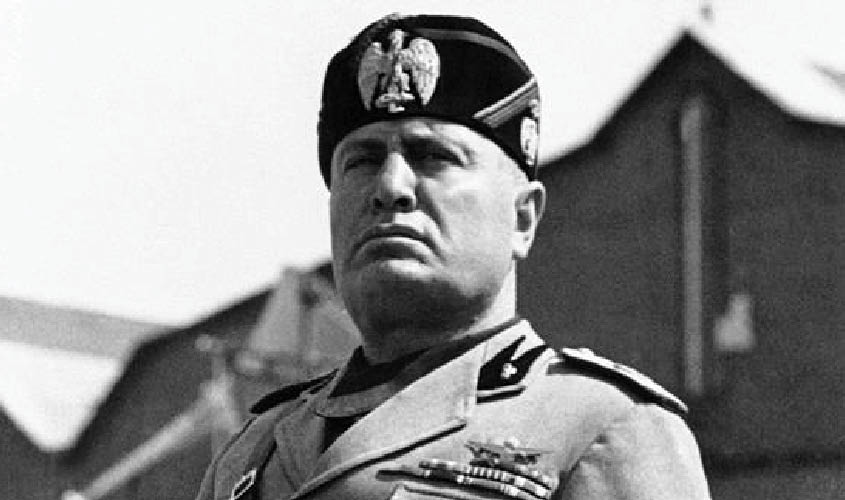Benito Mussolini (1883-1945) was the originator of Fascism. He ruled Italy from 1922-1943. His end was gory. He was shot, along with his long time mistress, Claretta Petacci on 29 April 1945 by Italian partisans on the shore of Lake Como. Their bodies were taken to Milan and displayed in Piazzale Loreto. Both bodies were hung upside down.
During the 1920s and 1930s, Mussolini was a man to reckon with. Praise was heaped on him by the likes of Churchill and George Bernard Shaw, Rabindranath Tagore and Mahatma Gandhi. Two noble and trusting souls whom Mussolini invited to Italy, to use them to laud his achievements. Both were taken in by the Duce’s (the word means leader) luminous deceptions.
Subhas Chandra Bose became a friend of Mussolini during 1941-1943. When he reached Kabul after his escape from Calcutta in January 1941, he assumed an Italian name for his journey from Kabul to Berlin—Orlando Mazzotta.
Mussolini, in the winter of 1925, sent two Orientalists, Carlo Formichi (a Fascist) and Giuseppe Tucci as visiting professors to Visva Bharati, with a collection of valuable books as gifts to Tagore’s university. Krishna Kripalani, in his biography of Tagore, writes, “Partly flattered by Mussolini’s courtship and partly curious to see for himself this colourful personality, Tagore accepted an invitation from Italy and sailed to Naples on 15 May 1926.” The poet’s political judgement was erratic at the best of times. “I am glad of this opportunity to see for myself the work of one who is assuredly a great man and movement that will certainly be remembered in history”, Tagore said before departure. Kripalani calls this Tagore’s “illusion”. Tagore was taken to Rome by special train. After meeting Mussolini he made an astonishing observation. “His Excellency Mussolini seems modelled body and soul by the Chisel of Michelangelo…” He lectured on “The Meaning of Art”. Mussolini was among the audience. He met King Victor Emmanuel III and the elusive philosopher Benedetto Croce. He also made a trip to Florence.
From Italy he travelled to Geneva, where Romain Rolland told him how his speeches had been misused by newspapers to praise the Fascist regime. He was shocked. His naivety once again led him to disaster. He was a big enough man to recognise his folly. He said to one of his entourage: “It was a sinister design on the part of my evil fate to have brought me into any relation with a man who may altogether be a fraud and no real personality. Somehow I have the knack of getting myself entangled in responsibilities that should have been avoided and I regret that I ever allowed myself to pay this visit to Italy.” But damage had been done.
On his return journey to India after attending the Second Round Table Conference in London in December 1931, Mahatma Gandhi was in Geneva for a week. He spent several hours each day in talks with Romain Rolland, whose short biography of the Mahatma (published in 1924) had added to Gandhi’s fame in Europe. This Gandhi had himself acknowledged.
On 8 December, Gandhi informed Rolland of his intention to go to Rome to meet Mussolini. Romain Rolland did his best to discourage Gandhi. “You will be isolated and shut in. Everyone round you will be Fascists, even the foreign journalists.” Romain Rolland reminded Gandhi of Tagore’s visit in 1926. Gandhi ignored Rolland’s warning.
Gandhi travelled from Milan (where he was cheered by a large crowd) in a special train. In Rome he stayed with a friend of Rolland, General Moris Monte. The Pope declined to see him. Mussolini met him for 20 minutes. He was respectful and attentive, asking questions about India. Gandhi spent a couple of hours in the Vatican library. He also looked into two of Madame Montessori’s schools and met the secretary of the Fascist Party. All his statements, speeches were garbled in the newspaper, deliberately made to appear pro Fascist. Gandhi was unaware of the tricks being played on him. The word, “non-violence” was eliminated from all his speeches. Put simply, he got the Tagore treatment. A bogus interview with the Mahatma was published in the widely read Giornale D’ Italia.
On board S.S Pilsana, Gandhi, on 20.12.1931 wrote in laudatory terms about Mussolini to Rolland: “Mussolini is an enigma to me. Many of his reforms he has made attract me. He seems to have done a great deal for the peasantry…what strikes me is that behind Mussolini’s ruthlessness is the motive of serving people. Even behind his bombastic speeches there is a ring of sincerity and love of his people. It also seems to me that the bulk of the Italians like Mussolini’s iron rule…”
Mahatma Gandhi never attributed evil in any man, but his goodness and holiness made him take the wrong path more than once.
Finally to Jawaharlal Nehru. He was returning to India from Lausanne with the ashes of his wife, who had passed away on 28 February 1936. Nehru had to stop in Rome because the KLM plane was scheduled to land there.
Mussolini sent his chief of protocol to the airport, inviting Nehru to meet him at 6 pm. Jawaharlal Nehru and the chief of protocol argued for an hour. “The time fixed for the interview was upon us and I had my say. A telephone message was sent to the Duce’s palace that I could not come.”
I have written about these historic events because they are almost forgotten.

